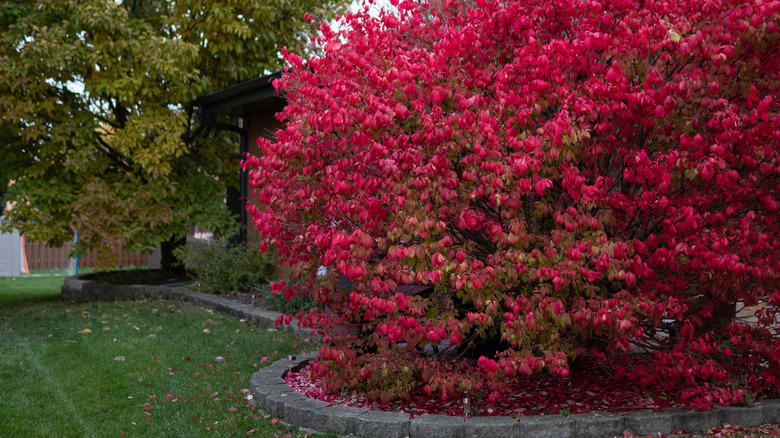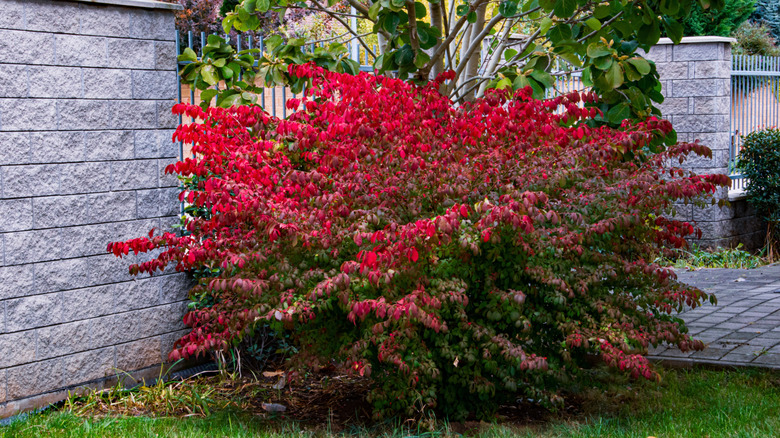The Fool-Proof Way To Get Rid Of A Burning Bush Plant
For decades, the burning bush (Euonymus alatus), also referred to as corky spindletree, was a staple in suburban landscaping. Its red foliage in the fall made it the perfect plant to watch the seasonal leaves change. But most homeowners don't know that those same vivid leaves belong to one of the most invasive ornamental plants in North America. Once planted, burning bush spreads aggressively, competing with native shrubs and tree seedlings by forming dense thickets. Birds eat the berries and carry seeds far beyond your yard, potentially creating a dense population of burning bushes in nearby woodlands. It's one of the "low-maintenance" shrubs that look beautiful but aren't worth growing in your yard. If you start to notice new sprouts popping up in spots where you didn't plant them, it might be time to take action.
Removing a burning bush plant isn't just about the aesthetics of your landscaping — it's an ecological matter, too. It's part of the reason why the burning bush shrub is banned in Massachusetts, New Hampshire, and Pennsylvania. It can quickly spread out of control, and a single mature plant can release hundreds of seeds. Getting rid of an aggressive burning bush might sound simple, but it requires a bit of finesse. For smaller plants, the best method is to just pull the intact root ball out of the ground, ensuring you get all of the plant material to prevent it from growing back. Larger shrubs are more complicated as they will need to be cut down before you can attempt to remove the roots. Both methods can be effective at removing a burning bush infestation in your lawn, but you will also need to take some preventative measures to ensure that it doesn't return.
How to effectively control the spread of burning bush plants
The most effective way to remove a burning bush plant is entirely dependent on the duration that it has been planted and the size of the shrub. For smaller ones, pulling the entire root system out by hand after heavy rain is typically enough. The loosened soil helps expose any remaining lateral roots that can take hold and grow back if left in the ground. Mature shrubs, on the other hand, often require more muscle or machinery. Cut the bush down close to the ground, then use a shovel to dig up the remaining root crown. If complete removal isn't possible, carefully apply a targeted herbicide that contains glyphosate or triclopyr to the freshly cut stumps to prevent any re-sprouting that may occur. Be sure to follow the instructions on the label and avoid spraying any surrounding plants, as even runoff can harm nearby root systems.
After you've successfully cleared the area, focus on long-term prevention. Monitor the space over the next few years for new seedlings, especially after heavy rainfall or increased bird activity around your garden. Mulching can be effective at preventing regrowth, but the real key is replanting the area with competitive, good alternatives for invasive burning bush plants like red chokecherry, Virginia sweetspire, or oakleaf hydrangea. These native shrubs will not only fill the space quickly, but will also provide plenty of food and shelter for pollinators and birds — the opposite of what the burning bush offers. Dispose of all plant material properly, never composting seed-bearing branches, as even a few stray seedlings can spread this invasive plant. With consistency and care, you can reclaim your yard from an out-of-control burning bush, ensuring that your landscaping remains beautiful and ecologically balanced for years to come.

